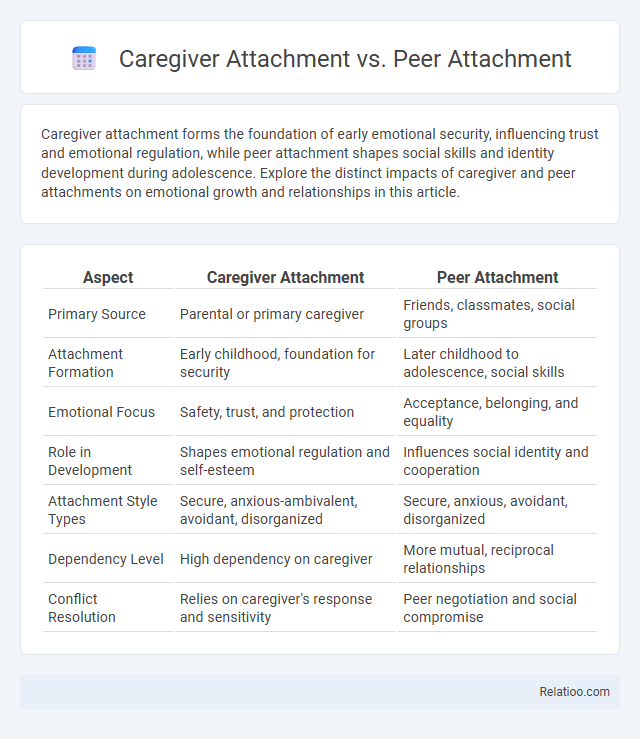Caregiver attachment forms the foundation of early emotional security, influencing trust and emotional regulation, while peer attachment shapes social skills and identity development during adolescence. Explore the distinct impacts of caregiver and peer attachments on emotional growth and relationships in this article.
Table of Comparison
| Aspect | Caregiver Attachment | Peer Attachment |
|---|---|---|
| Primary Source | Parental or primary caregiver | Friends, classmates, social groups |
| Attachment Formation | Early childhood, foundation for security | Later childhood to adolescence, social skills |
| Emotional Focus | Safety, trust, and protection | Acceptance, belonging, and equality |
| Role in Development | Shapes emotional regulation and self-esteem | Influences social identity and cooperation |
| Attachment Style Types | Secure, anxious-ambivalent, avoidant, disorganized | Secure, anxious, avoidant, disorganized |
| Dependency Level | High dependency on caregiver | More mutual, reciprocal relationships |
| Conflict Resolution | Relies on caregiver's response and sensitivity | Peer negotiation and social compromise |
Understanding Attachment Theory: Core Concepts
Attachment theory explores the emotional bonds formed between individuals, highlighting differences between caregiver attachment, peer attachment, and attachment figures. Caregiver attachment establishes foundational security and trust during early development, while peer attachment supports social skills and emotional regulation in later stages. Your understanding of these core concepts emphasizes how attachment figures influence lifelong relational patterns and psychological well-being.
Defining Caregiver Attachment
Caregiver attachment refers to the emotional bond formed between an infant and their primary caregiver, typically a parent, which shapes the child's sense of security and influences their social and emotional development. This attachment figure provides consistent care and responsiveness, fostering trust and safety essential for healthy relationships throughout life. Your early experiences with caregiver attachment form the foundation for how you relate to peers and other attachment figures later on.
Defining Peer Attachment
Peer attachment refers to the emotional bonds and trust developed between individuals of similar age or social groups, playing a crucial role in social development and identity formation during adolescence. Unlike caregiver attachment, which bases on early life security with primary caregivers, peer attachment emphasizes mutual support, acceptance, and shared experiences among friends or classmates. Attachment figures encompass both caregivers and peers, representing key sources of comfort, security, and social connection throughout various life stages.
Stages of Attachment Development
Stages of attachment development involve the formation of bonds between a child and key figures such as caregivers, peers, and other attachment figures. Caregiver attachment typically develops first, beginning with the pre-attachment stage in infancy, progressing to clear-cut attachment, where your infant seeks comfort and security primarily from the caregiver. Peer attachment emerges later in childhood and adolescence, reflecting increasing social exploration and emotional support from friends, while other attachment figures, such as teachers or mentors, may contribute to a child's social and emotional growth during various developmental stages.
Emotional Impact: Caregiver Attachment vs Peer Attachment
Caregiver attachment lays the foundation for emotional security and regulates your stress response during early development, fostering trust and safety essential for healthy emotional growth. Peer attachment influences social skills and emotional regulation in adolescence, shaping your self-esteem and interpersonal relationships through shared experiences and mutual support. The attachment figure, typically a primary caregiver, provides consistent emotional availability, which differs significantly from the evolving, reciprocal nature of peer attachments that contribute to independence and identity formation.
Social Skill Formation in Both Attachment Types
Caregiver attachment plays a crucial role in your early social skill formation by establishing a secure base for trust and emotional regulation, while peer attachment further develops abilities like cooperation, empathy, and conflict resolution through interactive experiences. Attachment figures, encompassing both caregivers and peers, collectively influence the development of social competencies essential for healthy relationships and effective communication. Understanding the distinct yet complementary functions of these attachment types highlights their importance in shaping social behavior and emotional intelligence.
Effects on Mental Health and Well-being
Caregiver attachment provides a foundational sense of security, significantly influencing Your emotional regulation and resilience, reducing anxiety and depression risk. Peer attachment contributes to social competence and self-esteem during adolescence, promoting better stress management and overall mental health. Attachment figures beyond caregivers and peers offer diverse emotional support networks, enhancing well-being and buffering psychological distress throughout life.
Cultural Influences on Attachment Styles
Cultural influences significantly shape caregiver attachment, peer attachment, and attachment figure dynamics by determining how emotional bonds and reliance are expressed within different societies. In collectivist cultures, caregiver attachment tends to emphasize interdependence and extended family roles, whereas peer attachment often incorporates communal values of loyalty and group harmony. Your understanding of these attachment styles benefits from recognizing that cultural norms dictate the expectations and behaviors associated with each attachment figure, influencing emotional development and relationship patterns.
Long-term Outcomes of Caregiver and Peer Bonds
Caregiver attachment lays the foundation for emotional security and shapes your ability to trust and regulate emotions throughout life, often resulting in healthier relationships and better stress management in adulthood. Peer attachment contributes significantly to social skills development and identity formation, influencing long-term outcomes such as self-esteem and social competence. The interplay between caregiver and peer bonds affects resilience and mental health, with secure attachment figures providing a buffering effect against adverse experiences.
Strengthening Healthy Attachments in Childhood and Adolescence
Caregiver attachment forms the foundation of emotional security, influencing your child's ability to trust and form bonds, while peer attachment supports social skills and identity development during adolescence. Strengthening healthy attachments involves consistent responsiveness from caregivers, promoting open communication and empathy in peer relationships. Fostering secure attachment figures in both family and social contexts enhances emotional regulation and resilience throughout childhood and adolescence.

Infographic: Caregiver Attachment vs Peer Attachment
 relatioo.com
relatioo.com